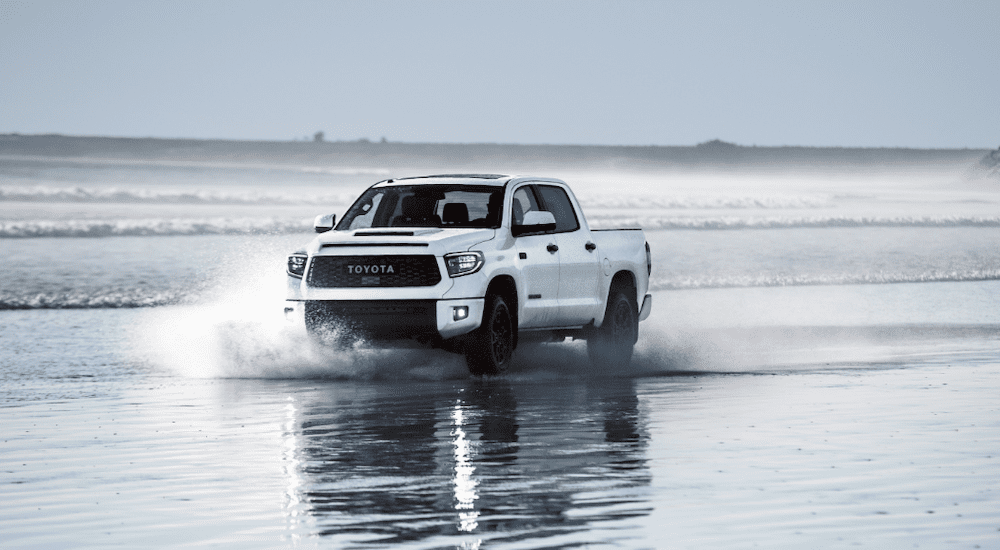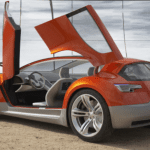Between the continued enthusiasm over the 2019 Toyota Tundra TRD Pro, and the February release of details regarding the 2020 flavor (along with its stablemate, the Tacoma) it’s hard not to appreciate everything Toyota has been bringing to the table over the last few years. But the TRD Pro still manages to set itself apart.
First introduced for the 2015 model year, the TRD Pro is inarguably reflective of the trend towards hi-po’d offerings most notably evidenced by the likes of the Raptor. But while Ford’s candidate might have garnered the lion’s share of attention in recent months, the Tundra predates it by entire model years, providing Toyota with opportunities for reflective refinement. And it’s with that in mind that we claim no surprise by the general sense of enthusiasm which has circled the TRD Pro since day one.
The Perfect Platform
I recently read an article, detailing the reasons why the Tundra served as the perfect platform for Special Editions. Countless examples were given, from the Tundra CrewMax 1794 Edition to the FTX Concept that had first been revealed at the NAIAS back in 2004. And while Rock Warriors and ‘Tundrasines’ (a Tundra, converted into an extended limousine) have created any number of headlines over the years, it’s easy to see why the Tundra provides such a limitless palate.

So, it’s really no surprise that the years to follow would unveil some really compelling takes on the Tundra (be they manufacturer special editions, or unique customs). But it was a 2008 offering that proved to be the real game-changer.
Supercharged
Beginning in 2008, Toyota began to offer a bolt-on TRD Supercharger kit, to upgrade their 5.7-liter V8 engine. Utilizing twin four-lobe rotors, the kit upgraded the Tundra’s performance ratings to 504 hp and 550 lb-ft of torque. It also delivered a 4.4-second sprint to 60 mph and 13-second quarter-mile.
This alone proved, ahead of the curve, that Toyota had what it took to remain competitive in a developing segment that the average consumer was unaware of. However, it wouldn’t be smooth sailing straight through to that point. There were challenges to come in the form of rapid recalls for various steering and suspension issues. Impressively, Toyota was able to address these and retain their standing as one of the highest rated pick-up trucks, in terms of reliability. To that point, a Louisiana owner even reached 1 million miles on his 2007 Tundra, incurred over eight years of ownership. Certainly nothing to shake the proverbial stick at.
Enter the performance Wars
Despite the relative newness of the TRD Pro, Toyota Racing Development (TRD) is anything but a new presence, having first been established back in 1954 (under the name TOSCO). Setting (and breaking) a variety of racing records, the renamed company would gain an American presence by 1979. And by the early 90’s the company’s interests had expanded from track to trail, setting their sights on off-road domination. Winning numerous World Rally Championships, TRD had proven itself a master of two worlds; and in 1997, they aimed to bring their success to the mainstream.
Introducing the optional TRD Off-Road Package for the 1997 Tacoma, Toyota recognized the growing mainstream interest in performance-minded off-roading. And the release was an astounding success, proving them to be well ahead of a yet-undefined curve. And driven by the enthusiastic reception, they opted to release the Tacoma PreTunner Xtracab in 1998. This allowed buyers to buy a tricked-out Tacoma right off the dealers’ floor, without the need for aftermarket upgrades.
Moving into the new millennium, many TRD headlines would be based around the company’s growing presence in both the NASCAR and NHRA racing circuits. But the introduction of the TRD Pro Series represented the culmination of the company’s three-and-a-half decades of experience in such iconic races as the Baja 500 and Baja 1000. Offered for the Tundra, Tacoma and 4Runner, the TRD Pro Series claimed to be designed around lessons learned in the Mexican desert. Versatile and ambitious in their capabilities, these variants helped to pioneer the onslaught of performance-minded off-roaders to follow.
Flash-forward a few model years, and the 2019 Tundra TRD Pro continues to thrive. Priced to start around the $50,000 mark it comes configured with a Crew Max cab (seating up to five) and the ‘short’ (66.7-inch) bed. Equipped with a 5.7-liter i-ForceV8, paired to a six-speed automatic transmission the 4WD beast churns out 381 hp and 401 lb-ft of RAM. But how does the Tundra measure up against equally ambitious offerings?
Where the TRD fell short in recent years, is in their inability to match the intensity of Ford’s “extreme” re-branding of the Raptor. While most everyone ‘in the know’ was well-aware of the established credibility of Raptor badging, it was 2017 before that understanding crept into our collective cultural mindset. Suddenly, everyone was talking about the bigger, badder and off-roading F-150, despite its arguably inaccessible price point. And pricing only worked to drive the Raptor up, in terms of its aspirational status.
From a price perspective, it’s placement just above the Tundra is almost nominal. Offering seating for six, the inarguably capable Raptor is powered by a 3.5-liter EcoBoost twin-turbo V6 paired with a 10-speed automatic transmission. Wrangling 450 hp and 510 lb-ft of torque, it manages to out-perform the Tundra in more than a few categories.
And yet, one could argue that the two offerings aren’t really in direct competition. Once you factor in automaker loyalties, especially at a top-dollar price point, you’re unlikely to find many prospective buyers debating between the TRD Pro and Raptor. Performance off-roading has always been a niche segment for automakers to cater to and the vast majority of either vehicle sold is more likely to be an on-road showpiece than it is to be an off-roading battlewagon. Thus, it’s far more likely that either will be purchased as a result of brand loyalty, or based around the subjective nature of design. In other words, which one do you enjoy looking at more?
Is the Toyota Tundra TDR Pro Right For You?
Only you can decide for sure. And if you need some time to marinate on that decision, take your time. With the Chicago reveal of the upgrades being offered in the 2020 model, the best is yet to come.
At the end of the day, it’s near impossible to argue the TRD’s contribution to the popularity of today’s hi-po’d off-roaders. We’re just excited to see where Toyota takes things from here.



